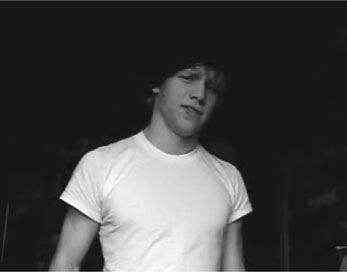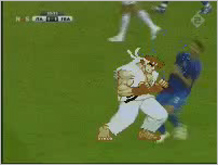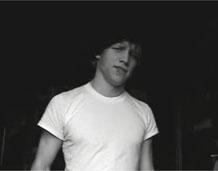TIME SHARES |
Organized by Rhizome and co-presented by the New Museum of Contemporary Art
|
FAULTLINES

Myspace Intro Playlist, Guthrie Lonergan, 2006
Over the past decade, as the Internet has become a mass medium, a number of large, dynamic communities have sprung up online. For instance, social networking sites like MySpace and Xanga boast millions of subscribers (mostly teenagers or young adults) and Second Life, which is both a game and a virtual civilization where players can do anything from organize art shows to buy condominiums, currently has upwards of 366,662 residents. Rhizome, itself, was founded as a global, Internet-based community in 1996. Here, as in societies offline, community is expressed as a complicated, disharmonious and productive place. The works in Faultlines consider the desires, fictions and anxieties embedded in online communities and also reveal how "real-world" issues, such as commerce and international politics, drive relationships in the virtual sphere just as they do offline.
WORKS
 |
|
Beacon, Jon Thomson and Alison Craighead, UK, 2005
Beacon presents a continuous stream of searches being typed live into Google by global visitors to the site. By isolating each term as it scrolls across the page, the artists frame the poetic nature of the web searches. Together the terms amount to a complex and far-ranging sociology of global curiosity and desire.
http://www.automatedbeacon.net/
|
 |
|
Agonistics, Warren Sack, US, 2005
The images and actions used metaphorically by political theorists to understand democratic discussion as a game or competition have been described as "agonistic democracy.". Agonistics: A Language Game is a literal instantiation of these metaphors that can played by posting messages to a public, online discussion forum.
Agonistics was a 2005 Rhizome Commission.
http://artport.whitney.org/gatepages/artists/sack/
|
 |
|
The Dumpster (Valentine's Day, 06),
Golan Levin with Kamal Nigam and Jonathan Feinberg, US, 2006
The Dumpster is an interactive online visualization that attempts to depict a slice through the romantic lives of American teenagers. Using real postings extracted from millions of online blogs, visitors can surf through tens of thousands of romantic relationships in which one person has "dumped" another.
The Dumpster was a co-commission by Tate Online and artport, the Whitney Museum of American Art's net art portal.
http://artport.whitney.org/commissions/thedumpster/
|
 |
|
Tokyo Rose Advertising, Takuji Kogo, Japan, 2006
An eerie and playful critique of the fantasies often embedded in e-commerce or illicit websites. Kogo's animation features a pixilated image of a girlswaying her hips and mulling over consumerist desire. For the piece, the artist re-framed an animated gif he found online, amplifying the human characteristics of the original digital file.
http://artonline.jp/tokyorose.html
|
 |
|
Vanishing Point, Mauricio Arango, Colombia, 2006
Vanishing Point visualizes the global news economy. The piece consists of a map of the world connected to a database fed by news coming from the most widely read newspapers from countries in the Group of Seven (G7). Countries with much visibility appear darker while those paid little attention disappear progressively, reflecting the varying kinds of attention allotted by the international community.
This project was commisioned by Low-Fi The Net Art Locator in England.
http://www.low-fi.org.uk/vanishingpoint/
|
 |
|
Zidane Headbutt Animation Festival, Anil Dash, US, 2006
Created in response to the widespread reaction to the Zidane headbutt in the 2006 World Cup season, the Festival is a paradoc recycling of Zidane-themed digital images that popped up after the World Cup season came to a close. While not necessarily created as an artwork, the piece speaks to the immediate nature of online collaboration and the fleeting kinds of community that can develop.
http://www.dashes.com/anil/2006/07/11/zidane_world_cu
|
 |
|
MySpace Intro Playlist, Guthrie Lonergan, US, 2006
Just as one organizes a setlist or a mixtape, Lonergan sifted through dozens of Myspace "intros," brief video portraits of site users, to form Myspace Intro Playlist. In his compilation, the intros are separated from the larger profile to which they belong, to highlight the ways people market themselves, online, to a vast swathe of unknown peers.
http://www.youtube.com/view_play_list?p=EBF5D6DC4589D7B7
|

